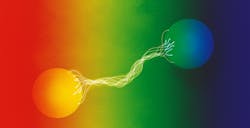Congratulations to Alain Aspect, John F. Clauser, and Anton Zeilinger!
Alain Aspect, of the Université Paris-Saclay and École Polytechnique, Palaiseau, France, John F. Clauser, J.F. Clauser & Assoc., Walnut Creek, Calif., U.S., and Anton Zeilinger, University of Vienna, Austria, each conducted groundbreaking experiments using entangled quantum states, in which two particles behave as a single unit even when separated. Their findings cleared the way for new technology based on quantum information.
Quantum mechanics has become a large field of research that includes quantum computers, quantum networks, and secure quantum encrypted communications.
In quantum mechanics, two or more particles can exist in an entangled state. What happens to one of the particles in an entangled pair determines what happens to the other particle—even if they’re far apart.
For many years, it was unknown whether the correlation was because the particles in an entangled pair contain hidden variables or instructions to tell them which result they should give in an experiment.
In the 1960s, John Stewart Bell developed the mathematical inequality named after him, which states that if hidden variables exist, the correlation between the results of a large number of measurements will never exceed a certain value. But quantum mechanics predicts that a certain type of experiment will violate Bell’s inequality and result in a stronger correlation than would otherwise be possible.
John Clauser developed John Bell’s ideas, which led to a practical experiment. His measurements supported quantum mechanics by clearly violating a Bell inequality. This means quantum mechanics can’t be replaced by a theory that uses hidden variables.
Loopholes remained after Clauser’s experiment, and Alain Aspect developed the setup, using it in a way that closed an important loophole. By switching measurement settings after an entangled pair left its source, the setting that existed when they were emitted couldn’t affect the result.
Anton Zeilinger started using entangled quantum states and his group demonstrated the phenomenon of quantum teleportation—which makes it possible to move a quantum state from one particle to one at a distance.
“It’s becoming increasingly clear that a new kind of quantum technology is emerging,” says Anders Irbäck, chair of the Nobel Committee for Physics. “We can see that the laureates’ work with entangled states is of great importance, even beyond the fundamental questions about the interpretation of quantum mechanics.”
About the Author
Sally Cole Johnson
Editor in Chief
Sally Cole Johnson, Laser Focus World’s editor in chief, is a science and technology journalist who specializes in physics and semiconductors.

